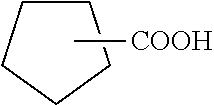New additive for inhibiting acid corrosion and method of using the new additive
a technology of acid corrosion and additives, which is applied in the direction of thermal non-catalytic cracking, separation processes, fuels, etc., can solve the problems of corroding equipment used to distill, severe corrosion problems, damage to piping and other associated equipment, etc., and achieve low phosphorous content, high thermal stability, and low acidity
- Summary
- Abstract
- Description
- Claims
- Application Information
AI Technical Summary
Benefits of technology
Problems solved by technology
Method used
Image
Examples
example 1
Synthesis of Polyisobutenyl succinate ester (PIB ester-hydroxyl terminated polymer compound)
Step 1: Polyisobutenyl succinic anhydride
[0074]
Details of compound% wt1HRPIB (OLOA 16500)89.482Maleic anhydride10.52Total size100.00
[0075]Procedure[0076]1. HRPIB (High Reactive Polyisobutylene) was charged into a clean and dry, four necked flask, equipped with nitrogen inlet, stirrer and thermometer.[0077]2. Temperature was raised to 125° C.[0078]3. N2 gas bubbling was started and continued for 10 minutes.[0079]4. Rate of N2 gas bubbling was reduced and, sample for moisture content was taken.[0080]5. Maleic anhydride was added to the flask.[0081]6. After addition of maleic anhydride, temperature was raised to 170° C. and maintained for 2 hours with nitrogen bubbling.[0082]7. After completion of maintaining of step 6 period, temperature was further raised to 205° C. and, heated at such a rate that it should reach—205° C. from 170° C. in 3 hours (5° C. / 25 min).[0083]8. The reaction mixture was ...
example 2
Synthesis of Polymeric Thiophosphate Ester (Invention-Compound) Obtained by Reaction of Compound of Step II of Example 1 (with Various Mole Ratios) with Phosphorous Pentasulphide (with Various Phosphorous Contents)
[0094]General Procedure for Making Polymeric Thiosulphate Ester[0095]1. PIB ester was charged into a clean and dry four necked flask equipped with nitrogen inlet, stirrer and thermometer and, temperature was raised to 90° C. with nitrogen gas bubbling[0096]2. Phosphorus pentasulfide was added at 90° C. slowly in one lot[0097]3. After addition of phosphorus pentasulfide temperature was raised to 120° C.[0098]4. Reaction mixture was maintained for 1 hour at 120° C.[0099]5. After 1 hour at 120° C., temperature was slowly raised to 140° C. and maintained for 1 hour. Then it was cooled to 90° C.[0100]6. Acid value of the as sample was measured as (45.61 mgKOH / g)[0101]7. The reaction mixture was diluted with 1:1 Toluene[0102]8. Temperature was raised to reflux point, nitrogen ga...
example 3
High Temperature Naphthenic Acid Corrosion Test
[0110]In this example, various amounts of a 50% formulation of the composition prepared in accordance, with Examples 1 to 3, were tested for corrosion inhibition efficiency on carbon steel coupons in hot neutral oil containing naphthenic acid. A weight loss coupon, immersion test was used to evaluate the invention compound for its effectiveness in inhibition of naphthenic acid corrosion at 290° C. temperature. Different dosage such as 300, 400 and 600 ppm of invention compound were used, as 50% active solution.
[0111]A static test on carbon steel coupon was conducted without using any additive. This test provided a blank test reading.
[0112]The reaction apparatus consisted of a one-litre four necked round bottom flask equipped with water condenser, N2 purger tube, thermometer pocket with thermometer and stirrer rod. 600 g (about 750 ml) paraffin hydrocarbon oil (D-130-fraction of higher than 290° C.) was taken in the flask. N2 gas purging...
PUM
| Property | Measurement | Unit |
|---|---|---|
| molecular weight | aaaaa | aaaaa |
| molecular weight | aaaaa | aaaaa |
| molecular weight | aaaaa | aaaaa |
Abstract
Description
Claims
Application Information
 Login to View More
Login to View More - R&D
- Intellectual Property
- Life Sciences
- Materials
- Tech Scout
- Unparalleled Data Quality
- Higher Quality Content
- 60% Fewer Hallucinations
Browse by: Latest US Patents, China's latest patents, Technical Efficacy Thesaurus, Application Domain, Technology Topic, Popular Technical Reports.
© 2025 PatSnap. All rights reserved.Legal|Privacy policy|Modern Slavery Act Transparency Statement|Sitemap|About US| Contact US: help@patsnap.com


